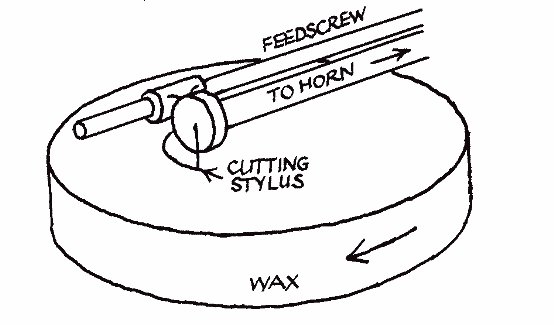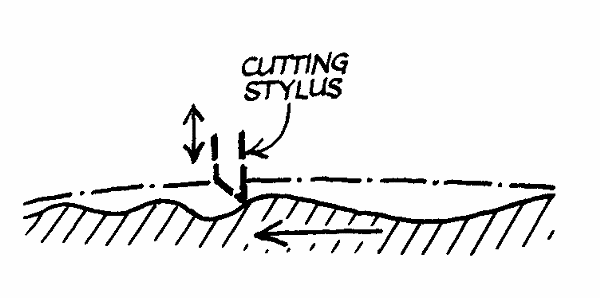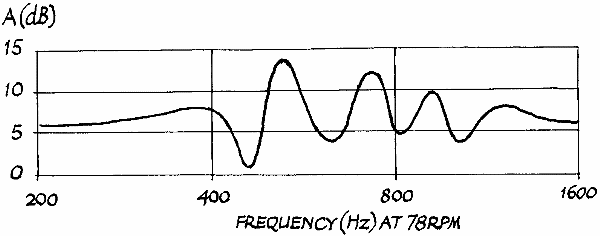George Brock-Nannestad - gbn.av@image.dk
Patent Tactics
Resedavej 40
DK-2820 Gentofte
Denmark
Popular version of paper 2pMU1
Presented Tuesday afternoon, May 25th, 2004
147th ASA Meeting, New York, NY
Broadly speaking, historical recordings (circa 1880 - 1950) are considered low- quality, and when they are re-issued it is regarded as an improvement when noises are removed, or according to modern psychoacoustic criteria, pushed into frequency bands where they are masked. However, not all noise removal provides us with a realistic sound from the recorded event.
Most of these recordings are grooved mechanical recordings, with the surface moving at a speed in the range 1 m/s under the element that interacts with the surface. This element is called a stylus, and in the generation of an original recording it is usually cutting a string of material away while being vibrated in accordance with the sound signal. Reproduction occurs when a similar, but not cutting, stylus follows a groove originally cut. Commercial records have several manufacturing steps between the creation of the groove and the physical object that is the mechanical record, such as a cylinder or a disc.


The need for durability of the groove surface called for additives to the resin it was made of, and 80 % of 'an old 78 rpm record' is actually pulverized stone material. The composition and screening of the material as well as the use of lubricants provided the best surface then available, and wear would only make it worse. A signal-to-noise ratio of 30 dB is not uncommon, but there are wide variations. The general public is now told that this noise is the most important irritant in early records, and that its removal means increasing the quality of recording. When you work scientifically with early records, it is not the noise but the spectral imbalances that are the most important.


At the same time, there is full awareness that an extended frequency range without prominent resonances is important, and this conflicts with much noise removal as performed today.
Sound example 1 is the surface noise from the groove of a 78 rpm shellac recording
Sound example 2 is the same surface noise amplified 20 dB
Generally, before 1925, there was no power amplification involved in recording; for this reason it is now termed 'acoustic recording'. The resonant properties of the recording horn and the recording soundbox contributed a filtering of the desired signal that needs to be compensated in replay. The sound generators (voice, instruments) ought to be represented with a spectral profile that is close to real life.


Compensation can be done with modern signal processing, but it is difficult to do in a process that concentrates on the noise. This is because the spectrum of the background noise in acoustic recordings has two contributions. One is broadband from the surface of the groove that is replayed, the other is the noise that was generated during the cutting of the groove, and this was filtered by the same soundbox and horn that made the recording in the first place. For certain recordings there is a simple relationship between this noise spectrum and the compensation that is needed. However, this also means that if the model for the noise that is used as the basis for the noise removal is too simplistic, the result is actually a reduction in quality.

Sound example 3 is coloured noise
However, even listeners at the time of recording, without modern access to compensating signal processing, must have found the sound recognizable, or they would not have accepted the recordings in the first place. It is hence important to identify the features that make the sound recognizable, and that is the area of musical acoustics.
Hence, in order to assess a historical recording it is important to identify the sound sources, the recording setup, and the process that was involved in the creation of the record. There are similarities between commercial and scientific recording. Previous work in this area has regarded the process as a linear process from sonic event to record to reproduction event. This is, however, an over-simplification, because it was in fact a feedback process - there are several feedback paths, among which a test for durability and an artistic assessment are very important. Sometimes the byproduct of the feedback provides more information than the commercial version, such as when a test record has been retrieved that in its time provoked a further take because it had a too large dynamic range that would have caused premature wear and dissatisfied customers.
The major problem complex regarding replay of early recordings is connected to the fact that the speed of the record was not standardized, the key the music was performed in was unknown, and the standard pitch that the key was based on was not nearly as standard as we might think. These problems are interlinked, because reproducing at a higher speed than recording causes a transposition upwards while reducing the duration. Conversely, reproducing at a lower speed proportionally increases the duration. However, keys are 'banded' at 6% (semitone) intevals, instruments may have tones or registers that are identifiable by a particular spectral 'recipe', and the standard pitches would most likely be a1=435, 440, or 452 Hz for Western classical music in the period of interest. Furthermore, the vibrato rate of e.g. the human voice is equally influenced, and deciding "tasteful/not tasteful" may be the final indicator in a practical case.

Sound example 4 is Nellie Melba singing a phrase of the music shown on Fig. 8
The reproduction has been spectrally corrected. Note Melba's very tight vibrato and singer's formant.
Comparing the many re-issues that are available on CD today we realize that there are many tastes in the reproduction and presentation of early recordings. However, these are mostly commercial endeavours, and scientific use of early recordings as sources requires us to go back to the originals and use manipulations based on fact, not on taste.